Zero-Shot Sand-Dust Image Restoration
Abstract
1. Introduction
- To the best of our knowledge, this paper is the first to propose a zero-shot learning method for sand-dust image restoration. Despite being a zero-shot learning method, the proposed method achieves superior performance in restoring real sand-dust images.
- A new joint-learning network structure model is proposed, and the network model is designed entirely based on the imaging principles of the physical model of atmospheric scattering. A modified U-Net network is used to obtain a clear image and transmission map. Considering the relationship among the input image, clear image and transmission map in the atmospheric scattering model, a convolutional network and fully connected layers are designed to obtain atmospheric light.
2. Related Work
2.1. Sand-Dust Image Enhancement and Restoration Methods
2.2. U-Net Architecture
3. Proposed Zero-Shot Method
3.1. Image Color Balance
3.2. Proposed Method Framework
3.3. Zero-Shot Network Architecture
3.4. Loss Function
4. Experiments
4.1. Experimental Configurations
4.2. Qualitative Evaluation
4.3. Quantitative Evaluation
4.4. Ablation Study
5. Conclusions
Author Contributions
Funding
Institutional Review Board Statement
Informed Consent Statement
Data Availability Statement
Acknowledgments
Conflicts of Interest
Abbreviations
| NGT | Normalized gamma transformation |
| SCBCH | Continuous color balancing method with overlapping histograms |
| BCGF | Blue channel compensation and guided image filtering |
| TLS | Tensor least squares optimization |
| DCP | Dark channel prior |
| GDCP | Generalization of the dark channel prior |
| HDCP | Halo-reduced dark channel prior |
| RBCP | Reversing the blue channel prior |
| FBE | Fusion-based enhancement |
| NPQI | Natural scene statistics and perceptual characteristics-based quality index |
| NIQE | Natural image quality evaluator |
References
- Quan, Y.; Tan, X.; Huang, Y.; Xu, Y.; Ji, H. Image desnowing via deep invertible separation. IEEE Trans. Circuits Syst. Video Technol. 2023, 33, 3133–3144. [Google Scholar] [CrossRef]
- Li, Y.; Lu, J.; Chen, H.; Wu, X.; Chen, X. Dilated Convolutional Transformer for High-Quality Image Deraining. In Proceedings of the IEEE/CVF Conference on Computer Vision and Pattern Recognition (CVPR) Workshops, Vancouver, BC, Canada, 17–24 June 2023; pp. 4199–4207. [Google Scholar]
- Song, Y.; He, Z.; Qian, H.; Du, X. Vision transformers for single image dehazing. IEEE Trans. Image Process. 2023, 32, 1927–1941. [Google Scholar] [CrossRef] [PubMed]
- Wang, H.; Zhang, W.; Bai, L.; Ren, P. Metalantis: A comprehensive underwater image enhancement framework. IEEE Trans. Geosci. Remote Sens. 2024, 62, 1–19. [Google Scholar] [CrossRef]
- Peng, Y.T.; Cao, K.; Cosman, P.C. Generalization of the dark channel prior for single image restoration. IEEE Trans. Image Process. 2018, 27, 2856–2868. [Google Scholar] [CrossRef]
- Gao, G.; Lai, H.; Jia, Z.; Liu, Y.; Wang, Y. Sand-dust image restoration based on reversing the blue channel prior. IEEE Photonics J. 2020, 12, 1–16. [Google Scholar] [CrossRef]
- Ning, Z.; Shanjun, M.; Mei, L. Visibility restoration algorithm of dust-degraded images. J. Image Graph. 2016, 21, 1585–1592. [Google Scholar]
- Yan, T.; Wang, L.; Wang, J. Method to Enhance Degraded Image in Dust Environment. J. Softw. 2014, 9, 2672–2677. [Google Scholar] [CrossRef]
- Shi, Z.; Feng, Y.; Zhao, M.; Zhang, E.; He, L. Normalised gamma transformation-based contrast-limited adaptive histogram equalisation with colour correction for sand-dust image enhancement. IET Image Process. 2020, 14, 747–756. [Google Scholar] [CrossRef]
- Park, T.H.; Eom, I.K. Sand-dust image enhancement using successive color balance with coincident chromatic histogram. IEEE Access 2021, 9, 19749–19760. [Google Scholar] [CrossRef]
- Alruwaili, M.; Gupta, L. A statistical adaptive algorithm for dust image enhancement and restoration. In Proceedings of the 2015 IEEE International Conference on Electro/Information Technology (EIT), Dekalb, IL, USA, 21–23 May 2015; pp. 286–289. [Google Scholar]
- Wang, J.; Pang, Y.; He, Y.; Liu, C. Enhancement for dust-sand storm images. In MultiMedia Modeling, Proceedings of the MultiMedia Modeling: 22nd International Conference, MMM 2016, Miami, FL, USA, 4–6 January 2016; Proceedings, Part I 22; Springer: Cham, Switzerland, 2016; pp. 842–849. [Google Scholar]
- Gao, G.; Lai, H.; Liu, Y.; Wang, L.; Jia, Z. Sandstorm image enhancement based on YUV space. Optik 2021, 226, 165659. [Google Scholar] [CrossRef]
- Gao, G.; Lai, H.; Wang, L.; Jia, Z. Color balance and sand-dust image enhancement in lab space. Multimed. Tools Appl. 2022, 81, 15349–15365. [Google Scholar] [CrossRef]
- Hua, Z.; Nie, B. Enhancement Algorithm for Sandstorm Images. In Proceedings of the 2021 2nd International Conference on Control, Robotics and Intelligent System, Qingdao, China, 20–22 August 2021; pp. 273–278. [Google Scholar]
- Cheng, Y.; Jia, Z.; Lai, H.; Yang, J.; Kasabov, N.K. A fast sand-dust image enhancement algorithm by blue channel compensation and guided image filtering. IEEE Access 2020, 8, 196690–196699. [Google Scholar] [CrossRef]
- Lee, H.S. Efficient Color Correction Using Normalized Singular Value for Duststorm Image Enhancement. J 2022, 5, 15–34. [Google Scholar] [CrossRef]
- Xu, G.; Wang, X.; Xu, X. Single image enhancement in sandstorm weather via tensor least square. IEEE/CAA J. Autom. Sin. 2020, 7, 1649–1661. [Google Scholar] [CrossRef]
- Li, M.; Liu, J.; Yang, W.; Sun, X.; Guo, Z. Structure-revealing low-light image enhancement via robust retinex model. IEEE Trans. Image Process. 2018, 27, 2828–2841. [Google Scholar] [CrossRef]
- Kenk, M.A.; Hassaballah, M.; Hameed, M.A.; Bekhet, S. Visibility Enhancer: Adaptable for Distorted Traffic Scenes by Dusty Weather. In Proceedings of the 2020 2nd Novel Intelligent and Leading Emerging Sciences Conference (NILES), Giza, Egypt, 24–26 October 2020; pp. 213–218. [Google Scholar]
- Fu, X.; Huang, Y.; Zeng, D.; Zhang, X.P.; Ding, X. A fusion-based enhancing approach for single sandstorm image. In Proceedings of the 2014 IEEE 16th International Workshop on Multimedia Signal Processing (MMSP), Jakarta, Indonesia, 22–24 September 2014; pp. 1–5. [Google Scholar]
- Cheng, Y.; Jia, Z.; Lai, H.; Yang, J.; Kasabov, N.K. Blue channel and fusion for sandstorm image enhancement. IEEE Access 2020, 8, 66931–66940. [Google Scholar] [CrossRef]
- Wang, B.; Wei, B.; Kang, Z.; Hu, L.; Li, C. Fast color balance and multi-path fusion for sandstorm image enhancement. Signal Image Video Process. 2021, 15, 637–644. [Google Scholar] [CrossRef]
- Hao, C.; Huicheng, L.; Guxue, G.; Hao, W.; Xuze, Q. Sand-dust Image Enhancement Based on Multi-exposure Image Fusion. Acta Photonica Sin. 2021, 50, 0910003. [Google Scholar]
- Yu, S.; Zhu, H.; Wang, J.; Fu, Z.; Xue, S.; Shi, H. Single sand-dust image restoration using information loss constraint. J. Mod. Opt. 2016, 63, 2121–2130. [Google Scholar] [CrossRef]
- Wang, Y.; Li, Y.; Zhang, T. The method of image restoration in the environments of dust. In Proceedings of the 2010 IEEE International Conference on Mechatronics and Automation, Xi’an, China, 4–7 August 2010; pp. 294–298. [Google Scholar]
- Wang, Y.; Li, Y.; Zhang, T. Study on the Method of Image Restoration in the Environment of Dust. In Proceedings of the 2010 6th International Conference on Wireless Communications Networking and Mobile Computing (WiCOM), Chengdu, China, 23–25 September 2010; pp. 1–4. [Google Scholar]
- Peng, Y.T.; Cosman, P.C. Single image restoration using scene ambient light differential. In Proceedings of the 2016 IEEE International Conference on Image Processing (ICIP), Phoenix, AZ, USA, 25–28 September 2016; pp. 1953–1957. [Google Scholar]
- Yan, Y.; Chen, G.k. Single image visibility restoration using optical compensation and pixel-by-pixel transmission estimation. J. Commun. 2017, 38, 48. [Google Scholar]
- Lee, H.S. Efficient Sandstorm Image Enhancement Using the Normalized Eigenvalue and Adaptive Dark Channel Prior. Technologies 2021, 9, 101. [Google Scholar] [CrossRef]
- Huang, S.C.; Ye, J.H.; Chen, B.H. An advanced single-image visibility restoration algorithm for real-world hazy scenes. IEEE Trans. Ind. Electron. 2014, 62, 2962–2972. [Google Scholar] [CrossRef]
- Huang, S.C.; Chen, B.H.; Wang, W.J. Visibility restoration of single hazy images captured in real-world weather conditions. IEEE Trans. Circuits Syst. Video Technol. 2014, 24, 1814–1824. [Google Scholar] [CrossRef]
- Liu, J.; Liu, R.W.; Sun, J.; Zeng, T. Rank-One Prior: Real-Time Scene Recovery. IEEE Trans. Pattern Anal. Mach. Intell. 2022, 45, 8845–8860. [Google Scholar] [CrossRef] [PubMed]
- Si, Y.; Yang, F.; Guo, Y.; Zhang, W.; Yang, Y. A comprehensive benchmark analysis for sand dust image reconstruction. J. Vis. Commun. Image Represent. 2022, 89, 103638. [Google Scholar] [CrossRef]
- Si, Y.; Yang, F.; Liu, Z. Sand dust image visibility enhancement algorithm via fusion strategy. Sci. Rep. 2022, 12, 13226. [Google Scholar] [CrossRef]
- Shi, Z.; Liu, C.; Ren, W.; Shuangli, D.; Zhao, M. Convolutional neural networks for sand dust image color restoration and visibility enhancement. J. Image Graph. 2022, 27, 1493–1508. [Google Scholar] [CrossRef]
- Ding, B.; Chen, H.; Xu, L.; Zhang, R. Restoration of single sand-dust image based on style transformation and unsupervised adversarial learning. IEEE Access 2022, 10, 90092–90100. [Google Scholar] [CrossRef]
- Gao, Y.; Xu, W.; Lu, Y. Let you see in haze and sandstorm: Two-in-one low-visibility enhancement network. IEEE Trans. Instrum. Meas. 2023, 72, 1–12. [Google Scholar] [CrossRef]
- Gao, G.; Lai, H.; Jia, Z. Two-Step Unsupervised Approach for Sand-Dust Image Enhancement. Int. J. Intell. Syst. 2023, 2023, 4506331. [Google Scholar] [CrossRef]
- Meng, X.; Huang, J.; Li, Z.; Wang, C.; Teng, S.; Grau, A. DedustGAN: Unpaired learning for image dedusting based on Retinex with GANs. Expert Syst. Appl. 2024, 243, 122844. [Google Scholar] [CrossRef]
- Al-Ameen, Z. Visibility enhancement for images captured in dusty weather via tuned tri-threshold fuzzy intensification operators. Int. J. Intell. Syst. Appl. 2016, 8, 10. [Google Scholar] [CrossRef]
- Li, H.C.; Liu, X.L.C.; Pan, Z.R. Enhancement Algorithm of Dust Image Based on Multi-perceptual Feature Calculation. J. Lanzhou Univ. Technol. 2018, 4, 90–95. [Google Scholar]
- Shi, Z.; Feng, Y.; Zhao, M.; Zhang, E.; He, L. Let you see in sand dust weather: A method based on halo-reduced dark channel prior dehazing for sand-dust image enhancement. IEEE Access 2019, 7, 116722–116733. [Google Scholar] [CrossRef]
- Chen, B.H.; Huang, S.C. Improved visibility of single hazy images captured in inclement weather conditions. In Proceedings of the 2013 IEEE International Symposium on Multimedia, Anaheim, CA, USA, 9–11 December 2013; pp. 267–270. [Google Scholar]
- Zhang, X.S.; Yang, K.F.; Li, Y.J. Haze removal with channel-wise scattering coefficient awareness based on grey pixels. Opt. Express 2021, 29, 16619–16638. [Google Scholar] [CrossRef] [PubMed]
- Golts, A.; Freedman, D.; Elad, M. Unsupervised single image dehazing using dark channel prior loss. IEEE Trans. Image Process. 2019, 29, 2692–2701. [Google Scholar] [CrossRef]
- Ronneberger, O.; Fischer, P.; Brox, T. U-net: Convolutional networks for biomedical image segmentation. In Medical Image Computing and Computer-Assisted Intervention, Proceedings of the MICCAI 2015: 18th International Conference, Munich, Germany, 5–9 October 2015; Proceedings, Part III 18; Springer: Cham, Switzerland, 2015; pp. 234–241. [Google Scholar]
- Zhou, Z.; Rahman Siddiquee, M.M.; Tajbakhsh, N.; Liang, J. UNet++: A Nested U-Net Architecture for Medical Image Segmentation. In Deep Learning in Medical Image Analysis and Multimodal Learning for Clinical Decision Support, Proceedings of the Medical Image Computing and Computer-Assisted Intervention–MICCAI 2018, Granada, Spain, 20 September 2018; Springer: Cham, Switzerland, 2018; Volume 11073, pp. 3–11. [Google Scholar]
- Chen, J.; Lu, Y.; Yu, Q.; Luo, X.; Adeli, E.; Wang, Y.; Lu, L.; Yuille, A.L.; Zhou, Y. TransUNet: Transformers Make Strong Encoders for Medical Image Segmentation. IEEE Trans. Med Imaging 2022, 71, 4189–4198. [Google Scholar]
- Cao, H.; Wang, Y.; Chen, J.; Jiang, D.; Zhang, X.; Tian, Q.; Wang, M. Swin-Unet: Unet-like Pure Transformer for Medical Image Segmentation. In Computer Vision—ECCV 2022 Workshops, Proceedings of the ECCV 2022, Tel Aviv, Israel, 23—27 October 2022; Springer: Cham, Switzerland, 2022; Volume 13435, pp. 205–218. [Google Scholar]
- Liao, K.; Lin, C.; Zhao, Y.; Gabbouj, M. DR-GAN: Automatic radial distortion rectification using conditional GAN in real-time. IEEE Trans. Circuits Syst. Video Technol. 2019, 30, 725–733. [Google Scholar] [CrossRef]
- Li, X.; Zhang, B.; Sander, P.V.; Liao, J. Blind geometric distortion correction on images through deep learning. In Proceedings of the 2019 IEEE/CVF Conference on Computer Vision and Pattern Recognition (CVPR), Long Beach, CA, USA, 15–20 June 2019; pp. 4855–4864. [Google Scholar]
- Liao, K.; Yue, Z.; Wu, Z.; Loy, C.C. MOWA: Multiple-in-One Image Warping Model. arXiv 2024, arXiv:2404.10716. [Google Scholar]
- Koschmieder, H. Theorie der horizontalen Sichtweite. In Beitrage zur Physik der freien Atmosphare; Keim & Nemnich: Munich, Germany, 1924; pp. 33–53. [Google Scholar]
- Kar, A.; Dhara, S.K.; Sen, D.; Biswas, P.K. Zero-Shot Single Image Restoration Through Controlled Perturbation of Koschmieder’s Model. In Proceedings of the IEEE/CVF Conference on Computer Vision and Pattern Recognition, Nashville, TN, USA, 20–25 June 2021; pp. 16205–16215. [Google Scholar]
- Moorthy, A.K.; Bovik, A.C. Blind image quality assessment: From natural scene statistics to perceptual quality. IEEE Trans. Image Process. 2011, 20, 3350–3364. [Google Scholar] [CrossRef]
- Liu, Y.; Gu, K.; Li, X.; Zhang, Y. Blind image quality assessment by natural scene statistics and perceptual characteristics. ACM Trans. Multimed. Comput. Commun. Appl. (TOMM) 2020, 16, 1–91. [Google Scholar] [CrossRef]
- Mittal, A.; Soundararajan, R.; Bovik, A.C. Making a “completely blind” image quality analyzer. IEEE Signal Process. Lett. 2012, 20, 209–212. [Google Scholar] [CrossRef]
- Hautiere, N.; Tarel, J.P.; Aubert, D.; Dumont, E. Blind contrast enhancement assessment by gradient ratioing at visible edges. Image Anal. Stereol. 2008, 27, 87–95. [Google Scholar] [CrossRef]
- Shocher, A.; Cohen, N.; Irani, M. “zero-shot” super-resolution using deep internal learning. In Proceedings of the IEEE Conference on Computer Vision and Pattern Recognition, Salt Lake City, UT, USA, 18–23 June 2018; pp. 3118–3126. [Google Scholar]
- Kingma, D.; Ba, J. Adam: A Method for Stochastic Optimization. arXiv 2014, arXiv:1412.6980. [Google Scholar]

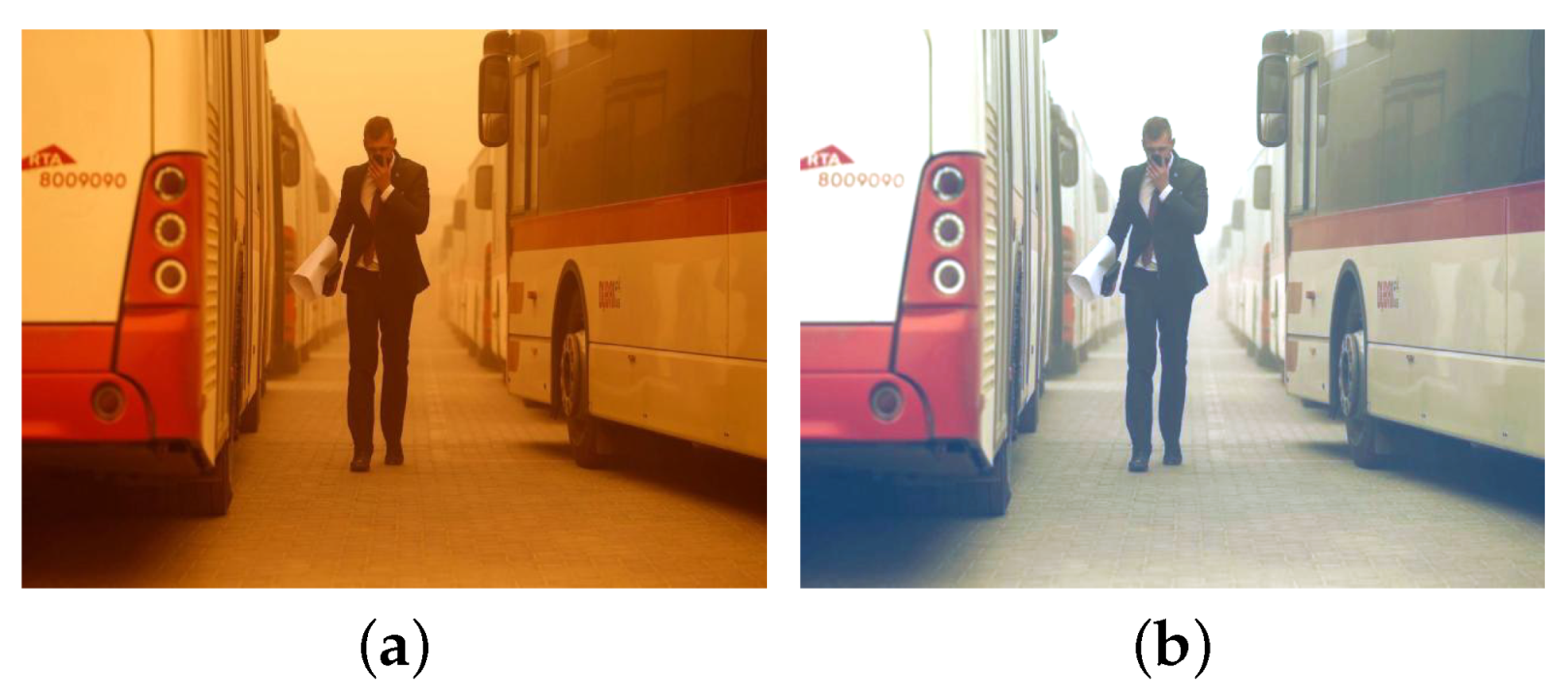
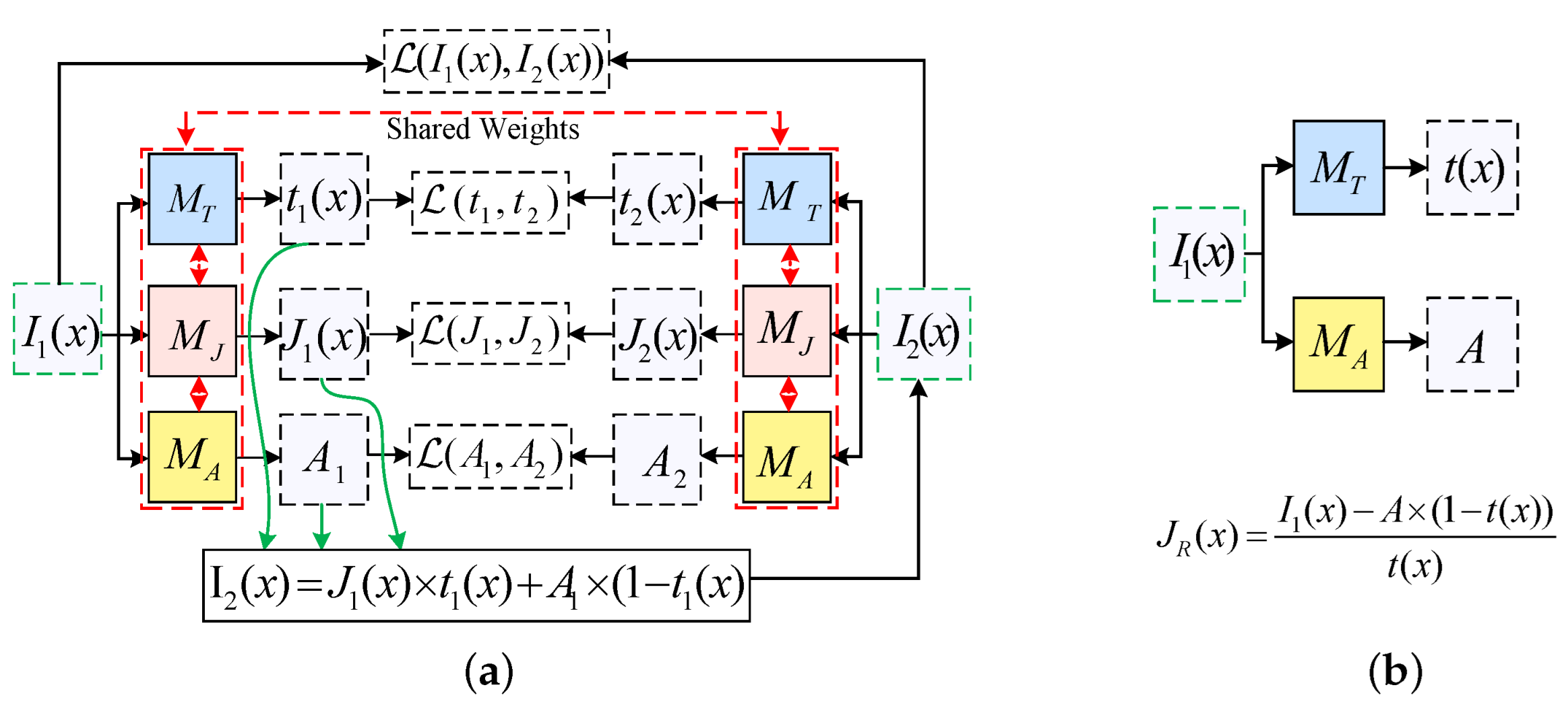
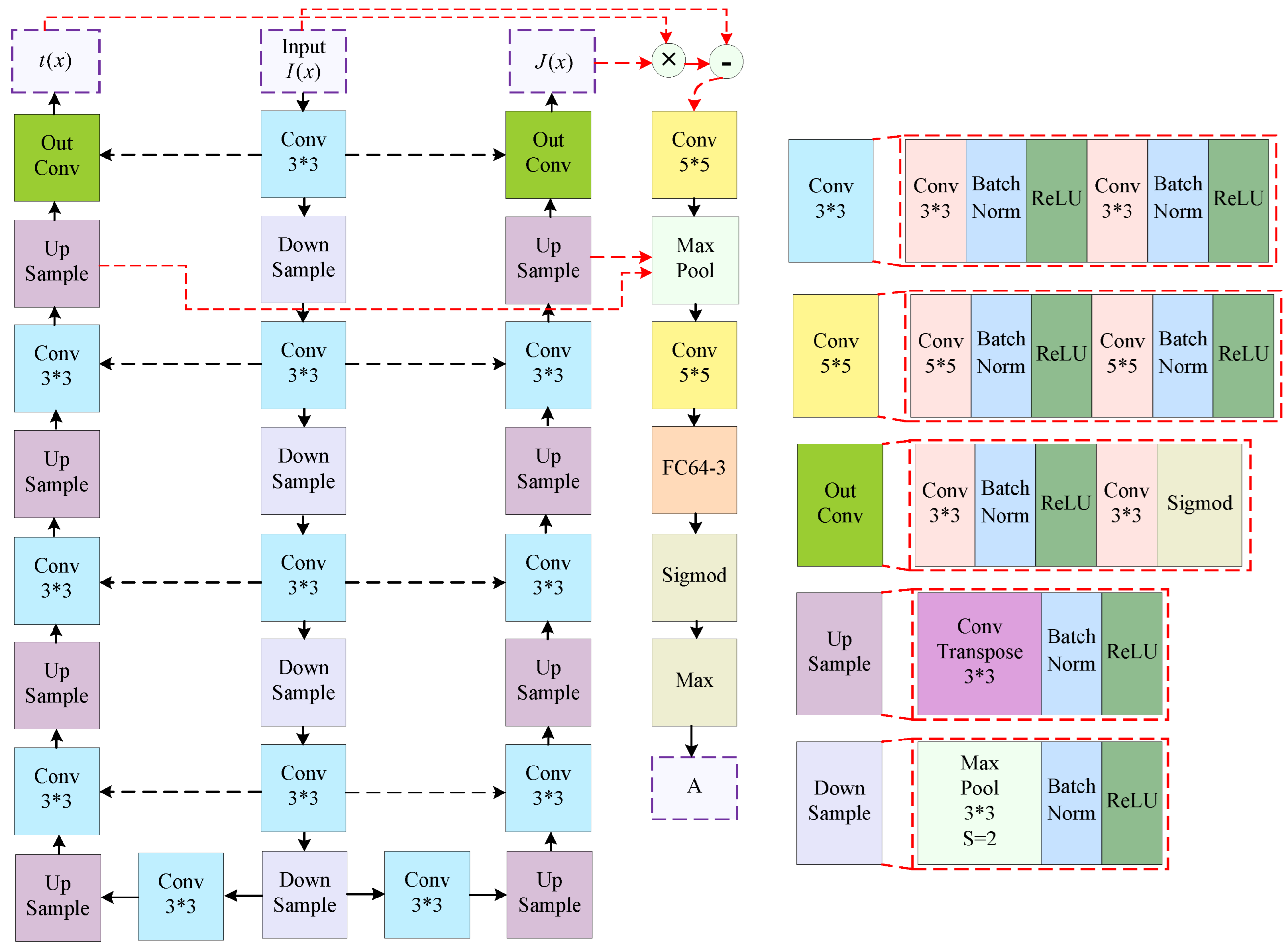
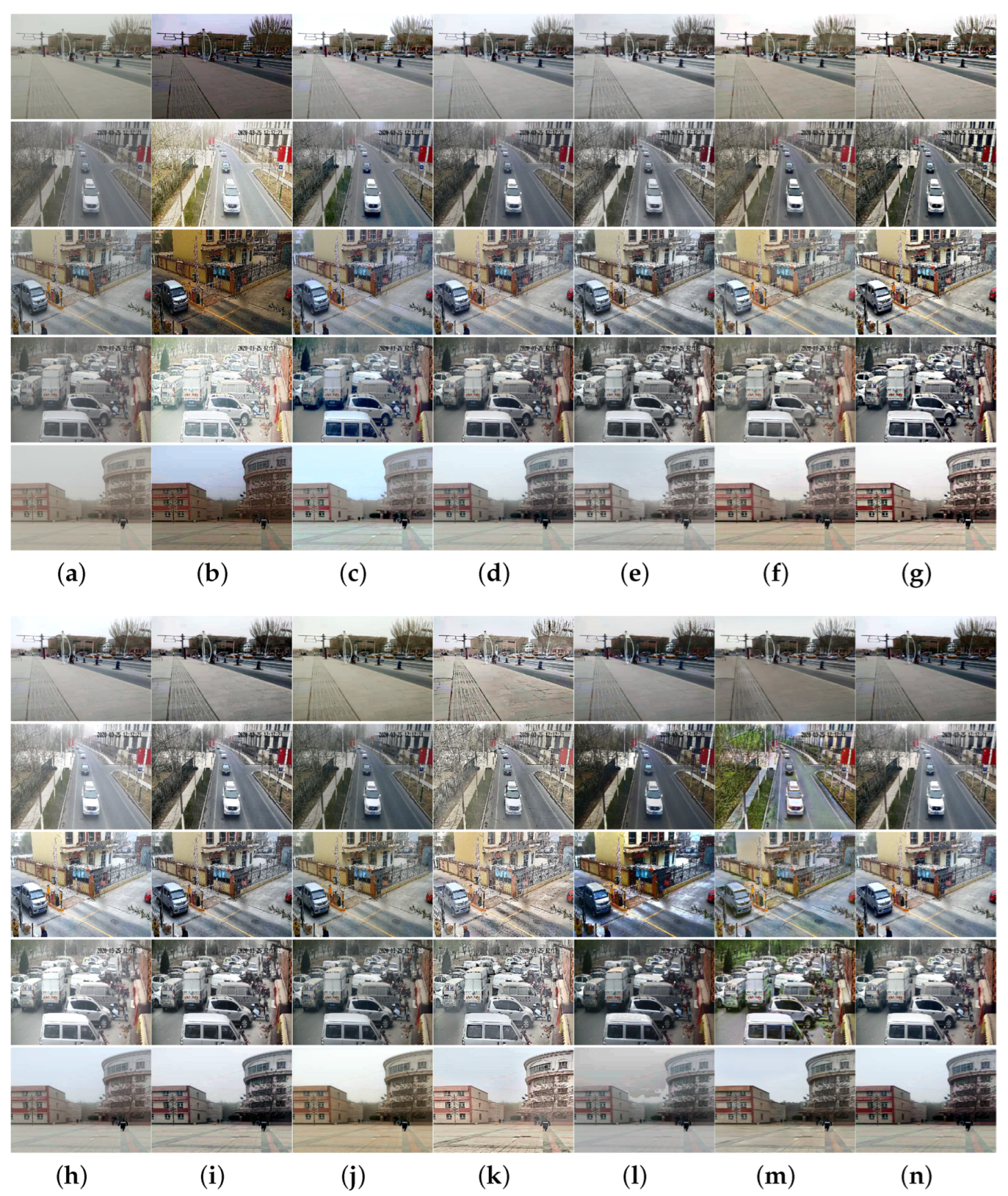
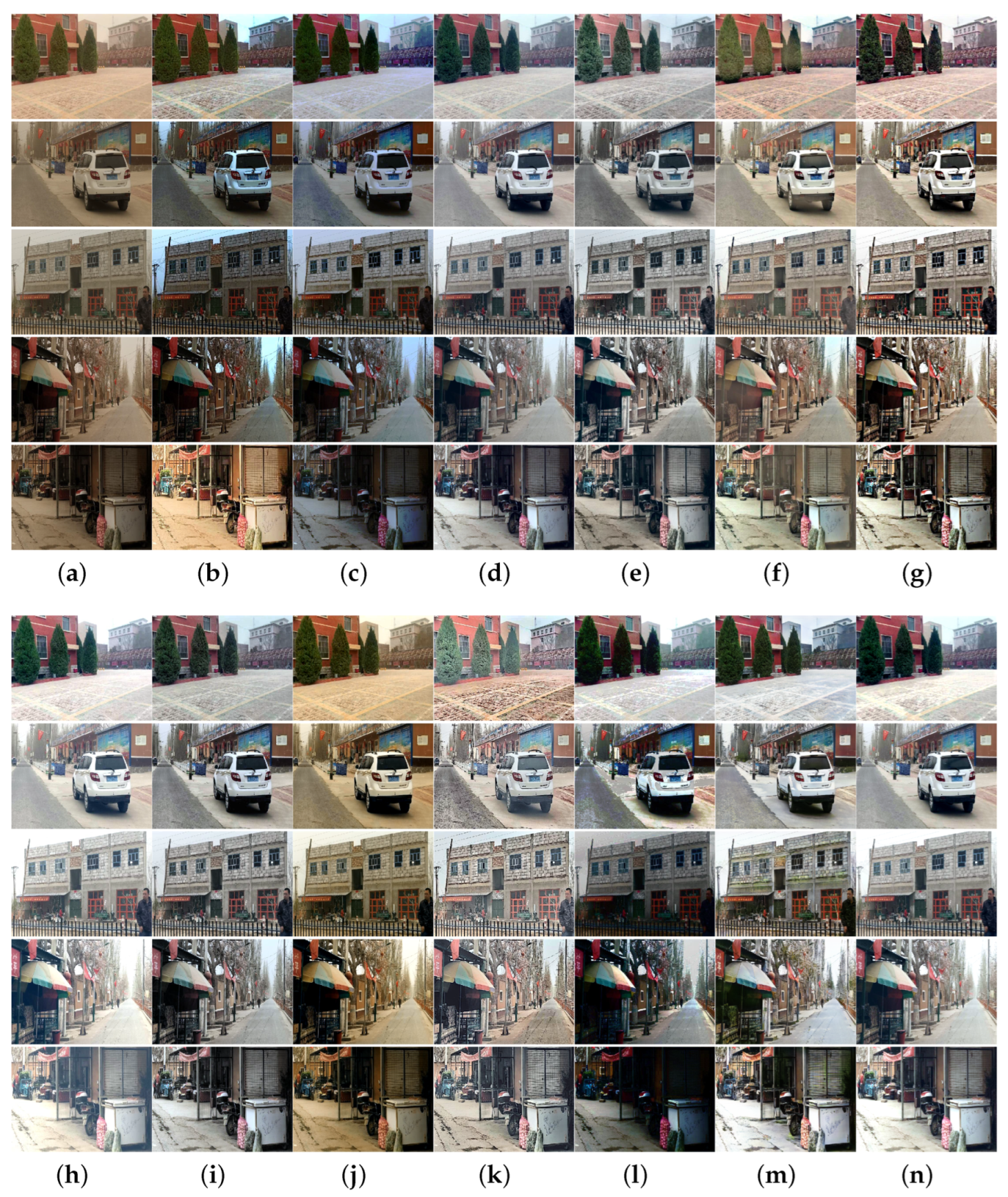


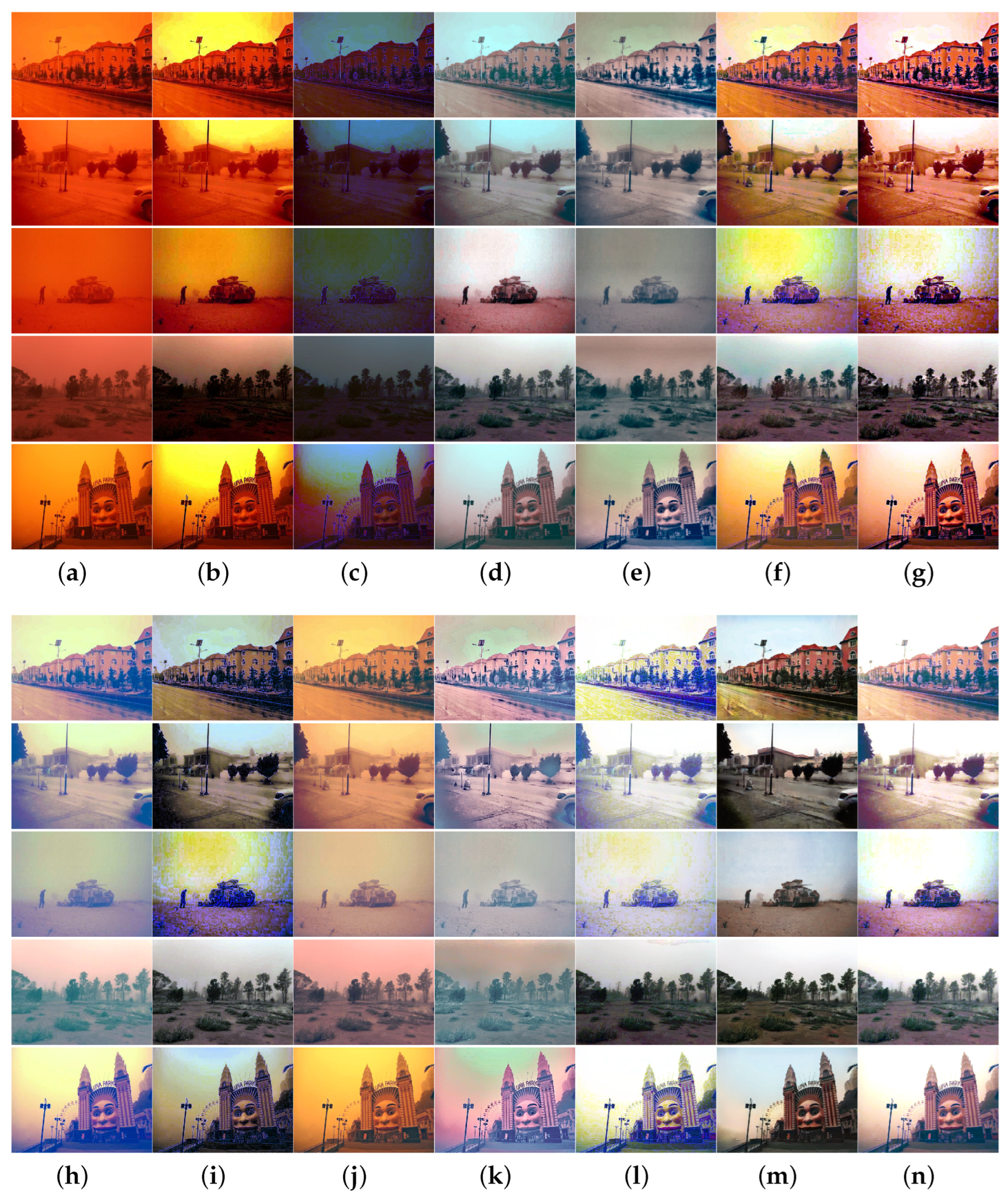

| Method | NIQE ↓ | DIIVINE ↑ | NPQI ↓ | |||
|---|---|---|---|---|---|---|
| GDCP [5] | 0.9137 | 0.2291 | 1.6784 | 3.9694 | 29.5532 | 12.2856 |
| RBCP [6] | 1.4863 | 0.1112 | 1.5531 | 3.979 | 30.7981 | 13.3088 |
| SCBCH [10] | 0.6106 | 0.0389 | 1.6838 | 3.7222 | 28.3511 | 11.0898 |
| NGT [9] | 0.4109 | 0.0056 | 1.8223 | 3.7858 | 25.4106 | 11.1056 |
| ROP [33] | 0.8444 | 0.0132 | 1.7258 | 3.7487 | 24.7047 | 11.8019 |
| BCGF [16] | 1.8427 | 0.6997 | 3.2769 | 3.8843 | 25.5295 | 11.4881 |
| TLS [18] | 0.0956 | 0.0059 | 1.4965 | 3.9467 | 31.7507 | 12.2684 |
| FBE [21] | 1.9576 | 0.1413 | 2.8525 | 3.8325 | 24.1332 | 10.5324 |
| TOENet [38] | 0.3259 | 1.2011 | 1.6010 | 3.7264 | 26.1932 | 11.2599 |
| HDCP [43] | 0.9905 | 0.1396 | 3.8849 | 4.1574 | 25.7301 | 12.1145 |
| DedustGAN [40] | 1.2122 | 0.0128 | 1.9202 | 3.9902 | 13.9408 | 12.1147 |
| SIENet [39] | 1.2428 | 0.0094 | 1.8845 | 3.8055 | 20.9273 | 11.4862 |
| Ours | 1.5434 | 0.0043 | 2.1766 | 3.6477 | 27.5495 | 10.6046 |
| Method | NIQE ↓ | DIIVINE ↑ | NPQI ↓ | |||
|---|---|---|---|---|---|---|
| GDCP [5] | - | 0.0717 | 1.7391 | 4.5527 | 38.6125 | 14.7407 |
| RBCP [6] | - | 0.102 | 1.6658 | 4.6593 | 40.2739 | 15.6666 |
| SCBCH [10] | - | 0.0654 | 1.8983 | 4.3238 | 39.4204 | 13.5423 |
| NGT [9] | - | 0.00006 | 1.9001 | 4.3936 | 35.6688 | 13.5000 |
| ROP [33] | - | 0.0087 | 2.2026 | 4.3379 | 35.0144 | 12.9264 |
| BCGF [16] | - | 0.5430 | 3.5192 | 4.3246 | 34.0732 | 13.199 |
| TLS [18] | - | 0.0536 | 1.4965 | 4.5909 | 42.9845 | 15.0563 |
| FBE [21] | - | 0.1397 | 2.6998 | 4.3437 | 34.5536 | 12.9475 |
| TOENet [38] | - | 0.2507 | 1.7650 | 4.0669 | 37.1339 | 13.6199 |
| HDCP [43] | - | 0.0199 | 4.5529 | 4.5226 | 30.4738 | 13.7403 |
| DedustGAN [40] | - | 0.091 | 3.8539 | 4.0215 | 19.0229 | 13.5084 |
| SIENet [39] | - | 0.0975 | 2.1398 | 4.3661 | 30.2219 | 12.9198 |
| Ours | - | 0.0897 | 2.3312 | 3.959 | 38.1299 | 12.8000 |
| Method | NIQE ↓ | DIIVINE ↑ | NPQI ↓ | |||
|---|---|---|---|---|---|---|
| GDCP [5] | 0.6197 | 0.2597 | 1.6029 | 4.0974 | 29.2947 | 11.1746 |
| RBCP [6] | 0.3482 | 0.4284 | 1.5271 | 3.8703 | 32.9548 | 10.4301 |
| SCBCH [10] | 0.3637 | 0.135 | 1.3703 | 3.7694 | 32.9136 | 10.3171 |
| NGT [9] | 0.3506 | 0.0026 | 1.7707 | 3.7218 | 27.326 | 9.705 |
| ROP [33] | 0.4042 | 0.0179 | 1.6389 | 3.7486 | 28.0376 | 12.0185 |
| BCGF [16] | 0.6387 | 0.8428 | 2.3283 | 3.9563 | 32.9117 | 10.5054 |
| TLS [18] | 0.2137 | 0.5202 | 1.4552 | 4.0519 | 38.49 | 10.5123 |
| FBE [21] | 0.5723 | 0.1614 | 1.7351 | 3.7598 | 29.1293 | 10.0479 |
| TOENet [38] | 0.4318 | 1.0574 | 1.4812 | 3.7103 | 28.3351 | 12.0144 |
| HDCP [43] | 0.5127 | 0.1478 | 3.4789 | 4.3531 | 23.5872 | 11.4722 |
| DedustGAN [40] | 0.5383 | 0.0258 | 1.9408 | 3.7074 | 16.3792 | 11.4295 |
| SIENet [39] | 0.54.1 | 0.0054 | 1.6834 | 3.8879 | 24.0551 | 11.2554 |
| Ours | 0.5633 | 0.2225 | 1.5227 | 3.6809 | 29.5885 | 10.6025 |
| NIQE ↓ | DIIVINE ↑ | NPQI ↓ | |||||||
|---|---|---|---|---|---|---|---|---|---|
| ✗ | ✓ | ✓ | ✓ | ✓ | 0.1471 | 1.7718 | 5.4957 | 26.1135 | 19.4831 |
| ✓ | ✗ | ✓ | ✓ | ✓ | 0.0275 | 1.5897 | 5.5769 | 32.0269 | 16.9101 |
| ✓ | ✓ | ✗ | ✓ | ✓ | 0.1127 | 1.7621 | 5.3012 | 26.8182 | 19.7357 |
| ✓ | ✓ | ✓ | ✗ | ✓ | 0.0451 | 2.2618 | 7.1590 | 31.9026 | 24.9664 |
| ✓ | ✓ | ✓ | ✓ | ✗ | 12.9885 | 1.8439 | 6.2291 | 30.0502 | 20.4819 |
| ✓ | ✓ | ✓ | ✓ | ✓ | 0.1561 | 1.927 | 3.824 | 33.8592 | 11.7013 |
Disclaimer/Publisher’s Note: The statements, opinions and data contained in all publications are solely those of the individual author(s) and contributor(s) and not of MDPI and/or the editor(s). MDPI and/or the editor(s) disclaim responsibility for any injury to people or property resulting from any ideas, methods, instructions or products referred to in the content. |
© 2025 by the authors. Licensee MDPI, Basel, Switzerland. This article is an open access article distributed under the terms and conditions of the Creative Commons Attribution (CC BY) license (https://creativecommons.org/licenses/by/4.0/).
Share and Cite
Shi, F.; Jia, Z.; Zhou, Y. Zero-Shot Sand-Dust Image Restoration. Sensors 2025, 25, 1889. https://doi.org/10.3390/s25061889
Shi F, Jia Z, Zhou Y. Zero-Shot Sand-Dust Image Restoration. Sensors. 2025; 25(6):1889. https://doi.org/10.3390/s25061889
Chicago/Turabian StyleShi, Fei, Zhenhong Jia, and Yanyun Zhou. 2025. "Zero-Shot Sand-Dust Image Restoration" Sensors 25, no. 6: 1889. https://doi.org/10.3390/s25061889
APA StyleShi, F., Jia, Z., & Zhou, Y. (2025). Zero-Shot Sand-Dust Image Restoration. Sensors, 25(6), 1889. https://doi.org/10.3390/s25061889






